Policy, Politics, and Law: Alcohol and Drug Use in Australia Essay
VerifiedAdded on 2021/04/21
|6
|1430
|238
Essay
AI Summary
This essay provides an overview of alcohol and drug use in Australia, examining its historical context, causes, and associated issues. It delves into the fluctuations in alcohol consumption over time and highlights the impact of the National Drug Household Survey. The essay explores the reasons behind substance use, including social, psychological, and environmental factors, and discusses the pervasive stigma faced by individuals struggling with addiction. It analyzes the barriers to treatment, including legislative principles, political influences, funding challenges, and the availability of drugs. The essay also presents strategies for reducing alcohol consumption, referencing WHO guidelines, and emphasizes the importance of early identification and intervention. It further examines the effects of stigma on individuals, including low self-esteem and social isolation, and explores how these factors can impede access to treatment and support. The essay concludes by highlighting the critical need for comprehensive approaches to address the complex challenges of alcohol and drug use in Australia.
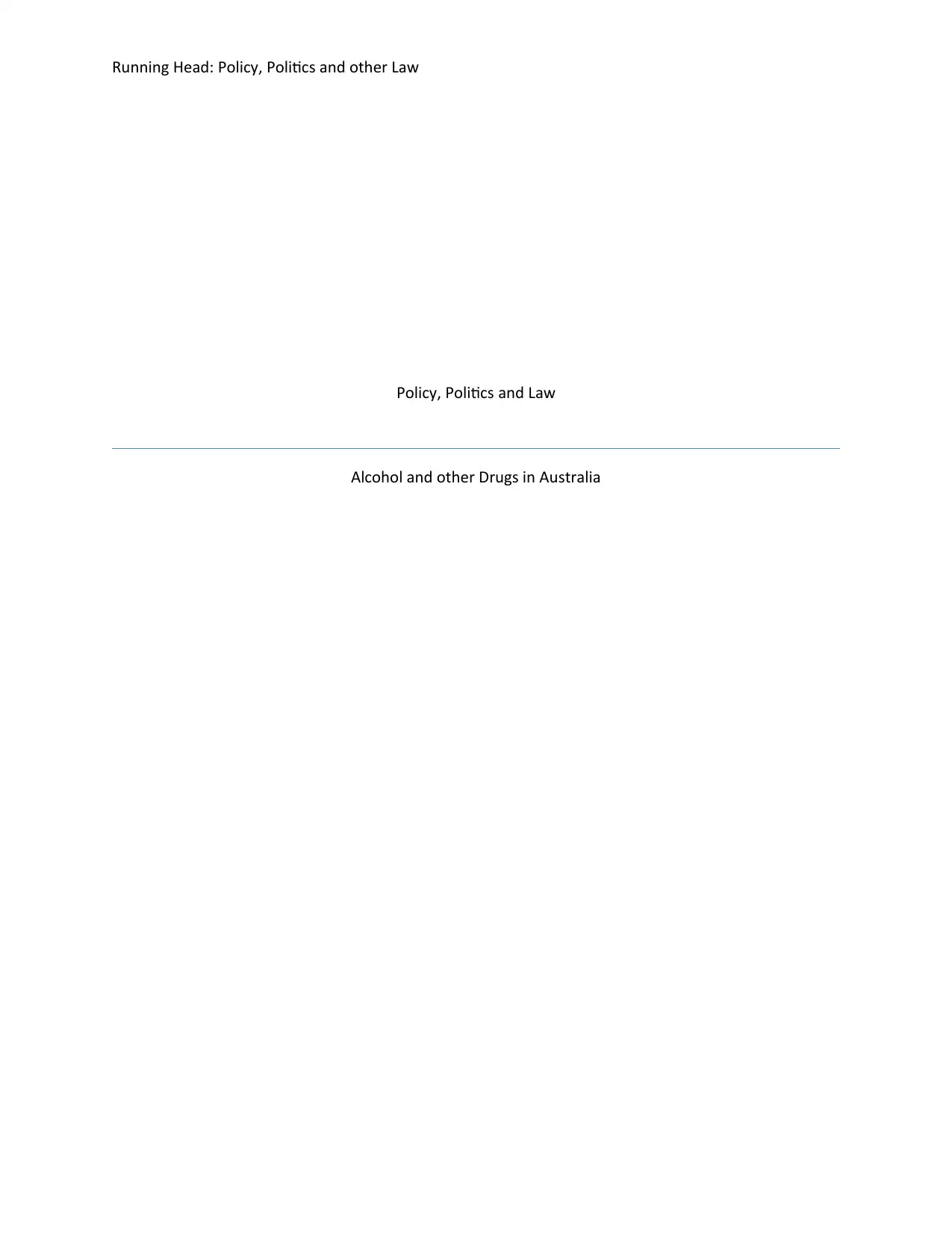
Running Head: Policy, Politics and other Law
Policy, Politics and Law
Alcohol and other Drugs in Australia
Policy, Politics and Law
Alcohol and other Drugs in Australia
Paraphrase This Document
Need a fresh take? Get an instant paraphrase of this document with our AI Paraphraser
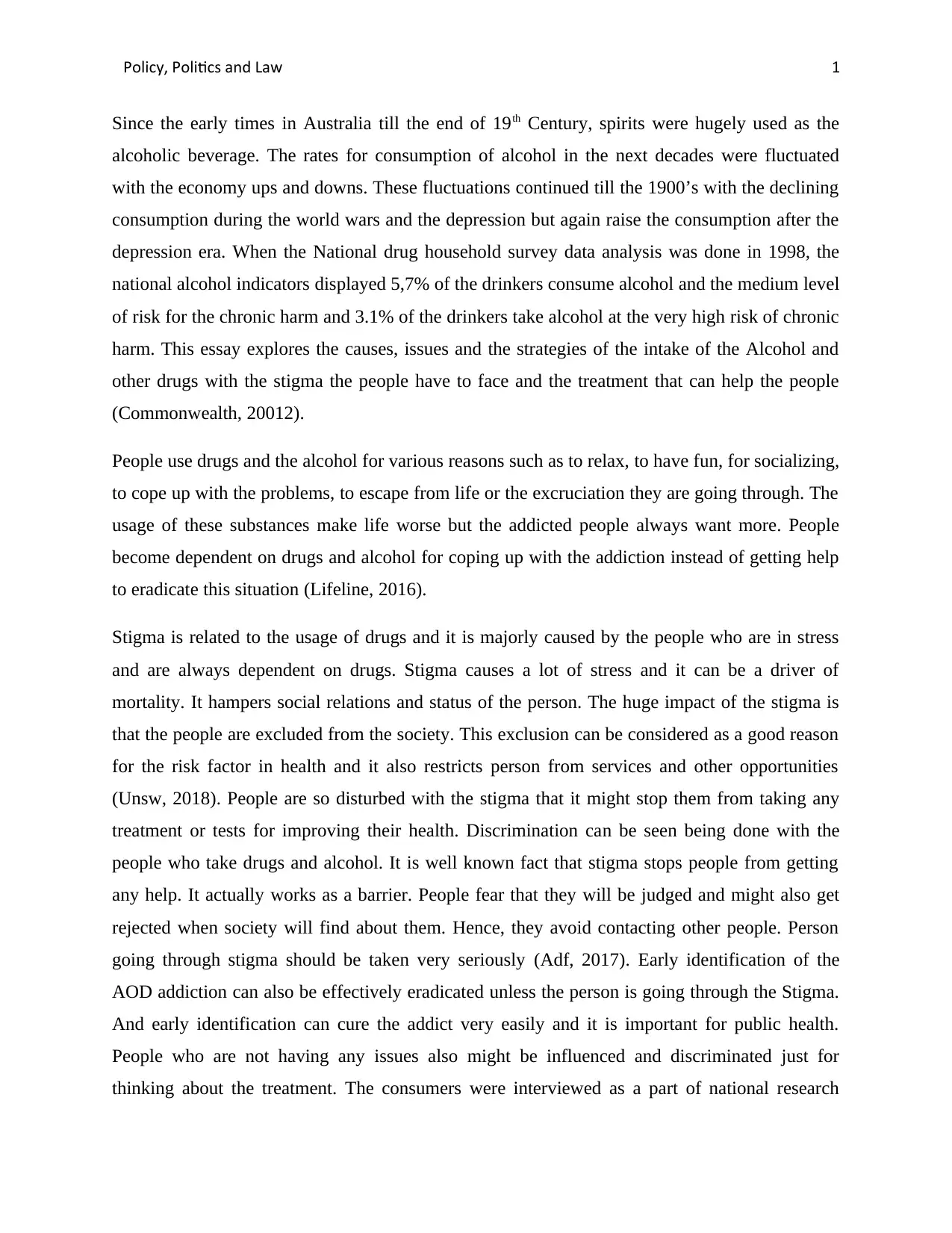
Policy, Politics and Law 1
Since the early times in Australia till the end of 19th Century, spirits were hugely used as the
alcoholic beverage. The rates for consumption of alcohol in the next decades were fluctuated
with the economy ups and downs. These fluctuations continued till the 1900’s with the declining
consumption during the world wars and the depression but again raise the consumption after the
depression era. When the National drug household survey data analysis was done in 1998, the
national alcohol indicators displayed 5,7% of the drinkers consume alcohol and the medium level
of risk for the chronic harm and 3.1% of the drinkers take alcohol at the very high risk of chronic
harm. This essay explores the causes, issues and the strategies of the intake of the Alcohol and
other drugs with the stigma the people have to face and the treatment that can help the people
(Commonwealth, 20012).
People use drugs and the alcohol for various reasons such as to relax, to have fun, for socializing,
to cope up with the problems, to escape from life or the excruciation they are going through. The
usage of these substances make life worse but the addicted people always want more. People
become dependent on drugs and alcohol for coping up with the addiction instead of getting help
to eradicate this situation (Lifeline, 2016).
Stigma is related to the usage of drugs and it is majorly caused by the people who are in stress
and are always dependent on drugs. Stigma causes a lot of stress and it can be a driver of
mortality. It hampers social relations and status of the person. The huge impact of the stigma is
that the people are excluded from the society. This exclusion can be considered as a good reason
for the risk factor in health and it also restricts person from services and other opportunities
(Unsw, 2018). People are so disturbed with the stigma that it might stop them from taking any
treatment or tests for improving their health. Discrimination can be seen being done with the
people who take drugs and alcohol. It is well known fact that stigma stops people from getting
any help. It actually works as a barrier. People fear that they will be judged and might also get
rejected when society will find about them. Hence, they avoid contacting other people. Person
going through stigma should be taken very seriously (Adf, 2017). Early identification of the
AOD addiction can also be effectively eradicated unless the person is going through the Stigma.
And early identification can cure the addict very easily and it is important for public health.
People who are not having any issues also might be influenced and discriminated just for
thinking about the treatment. The consumers were interviewed as a part of national research
Since the early times in Australia till the end of 19th Century, spirits were hugely used as the
alcoholic beverage. The rates for consumption of alcohol in the next decades were fluctuated
with the economy ups and downs. These fluctuations continued till the 1900’s with the declining
consumption during the world wars and the depression but again raise the consumption after the
depression era. When the National drug household survey data analysis was done in 1998, the
national alcohol indicators displayed 5,7% of the drinkers consume alcohol and the medium level
of risk for the chronic harm and 3.1% of the drinkers take alcohol at the very high risk of chronic
harm. This essay explores the causes, issues and the strategies of the intake of the Alcohol and
other drugs with the stigma the people have to face and the treatment that can help the people
(Commonwealth, 20012).
People use drugs and the alcohol for various reasons such as to relax, to have fun, for socializing,
to cope up with the problems, to escape from life or the excruciation they are going through. The
usage of these substances make life worse but the addicted people always want more. People
become dependent on drugs and alcohol for coping up with the addiction instead of getting help
to eradicate this situation (Lifeline, 2016).
Stigma is related to the usage of drugs and it is majorly caused by the people who are in stress
and are always dependent on drugs. Stigma causes a lot of stress and it can be a driver of
mortality. It hampers social relations and status of the person. The huge impact of the stigma is
that the people are excluded from the society. This exclusion can be considered as a good reason
for the risk factor in health and it also restricts person from services and other opportunities
(Unsw, 2018). People are so disturbed with the stigma that it might stop them from taking any
treatment or tests for improving their health. Discrimination can be seen being done with the
people who take drugs and alcohol. It is well known fact that stigma stops people from getting
any help. It actually works as a barrier. People fear that they will be judged and might also get
rejected when society will find about them. Hence, they avoid contacting other people. Person
going through stigma should be taken very seriously (Adf, 2017). Early identification of the
AOD addiction can also be effectively eradicated unless the person is going through the Stigma.
And early identification can cure the addict very easily and it is important for public health.
People who are not having any issues also might be influenced and discriminated just for
thinking about the treatment. The consumers were interviewed as a part of national research
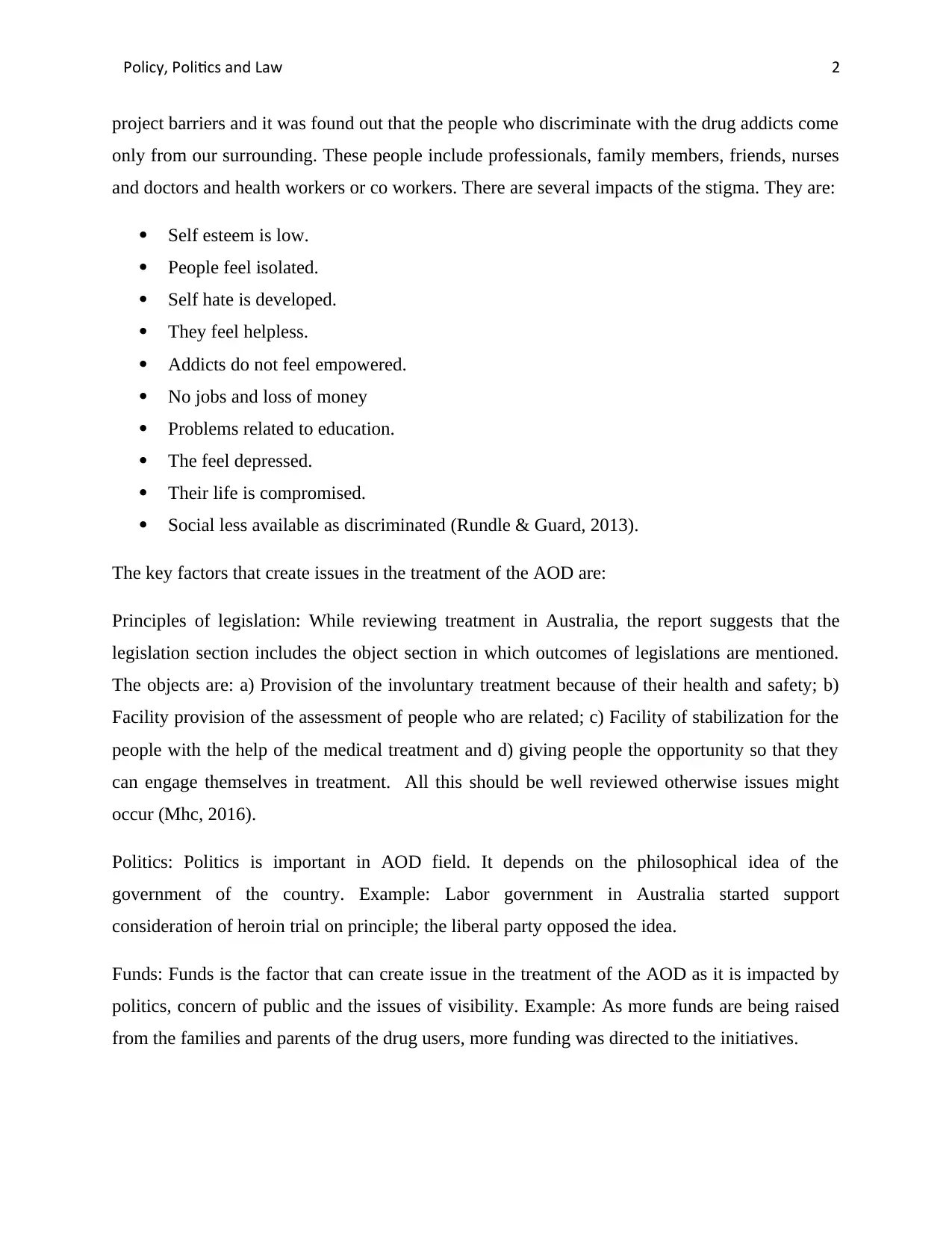
Policy, Politics and Law 2
project barriers and it was found out that the people who discriminate with the drug addicts come
only from our surrounding. These people include professionals, family members, friends, nurses
and doctors and health workers or co workers. There are several impacts of the stigma. They are:
Self esteem is low.
People feel isolated.
Self hate is developed.
They feel helpless.
Addicts do not feel empowered.
No jobs and loss of money
Problems related to education.
The feel depressed.
Their life is compromised.
Social less available as discriminated (Rundle & Guard, 2013).
The key factors that create issues in the treatment of the AOD are:
Principles of legislation: While reviewing treatment in Australia, the report suggests that the
legislation section includes the object section in which outcomes of legislations are mentioned.
The objects are: a) Provision of the involuntary treatment because of their health and safety; b)
Facility provision of the assessment of people who are related; c) Facility of stabilization for the
people with the help of the medical treatment and d) giving people the opportunity so that they
can engage themselves in treatment. All this should be well reviewed otherwise issues might
occur (Mhc, 2016).
Politics: Politics is important in AOD field. It depends on the philosophical idea of the
government of the country. Example: Labor government in Australia started support
consideration of heroin trial on principle; the liberal party opposed the idea.
Funds: Funds is the factor that can create issue in the treatment of the AOD as it is impacted by
politics, concern of public and the issues of visibility. Example: As more funds are being raised
from the families and parents of the drug users, more funding was directed to the initiatives.
project barriers and it was found out that the people who discriminate with the drug addicts come
only from our surrounding. These people include professionals, family members, friends, nurses
and doctors and health workers or co workers. There are several impacts of the stigma. They are:
Self esteem is low.
People feel isolated.
Self hate is developed.
They feel helpless.
Addicts do not feel empowered.
No jobs and loss of money
Problems related to education.
The feel depressed.
Their life is compromised.
Social less available as discriminated (Rundle & Guard, 2013).
The key factors that create issues in the treatment of the AOD are:
Principles of legislation: While reviewing treatment in Australia, the report suggests that the
legislation section includes the object section in which outcomes of legislations are mentioned.
The objects are: a) Provision of the involuntary treatment because of their health and safety; b)
Facility provision of the assessment of people who are related; c) Facility of stabilization for the
people with the help of the medical treatment and d) giving people the opportunity so that they
can engage themselves in treatment. All this should be well reviewed otherwise issues might
occur (Mhc, 2016).
Politics: Politics is important in AOD field. It depends on the philosophical idea of the
government of the country. Example: Labor government in Australia started support
consideration of heroin trial on principle; the liberal party opposed the idea.
Funds: Funds is the factor that can create issue in the treatment of the AOD as it is impacted by
politics, concern of public and the issues of visibility. Example: As more funds are being raised
from the families and parents of the drug users, more funding was directed to the initiatives.
⊘ This is a preview!⊘
Do you want full access?
Subscribe today to unlock all pages.

Trusted by 1+ million students worldwide
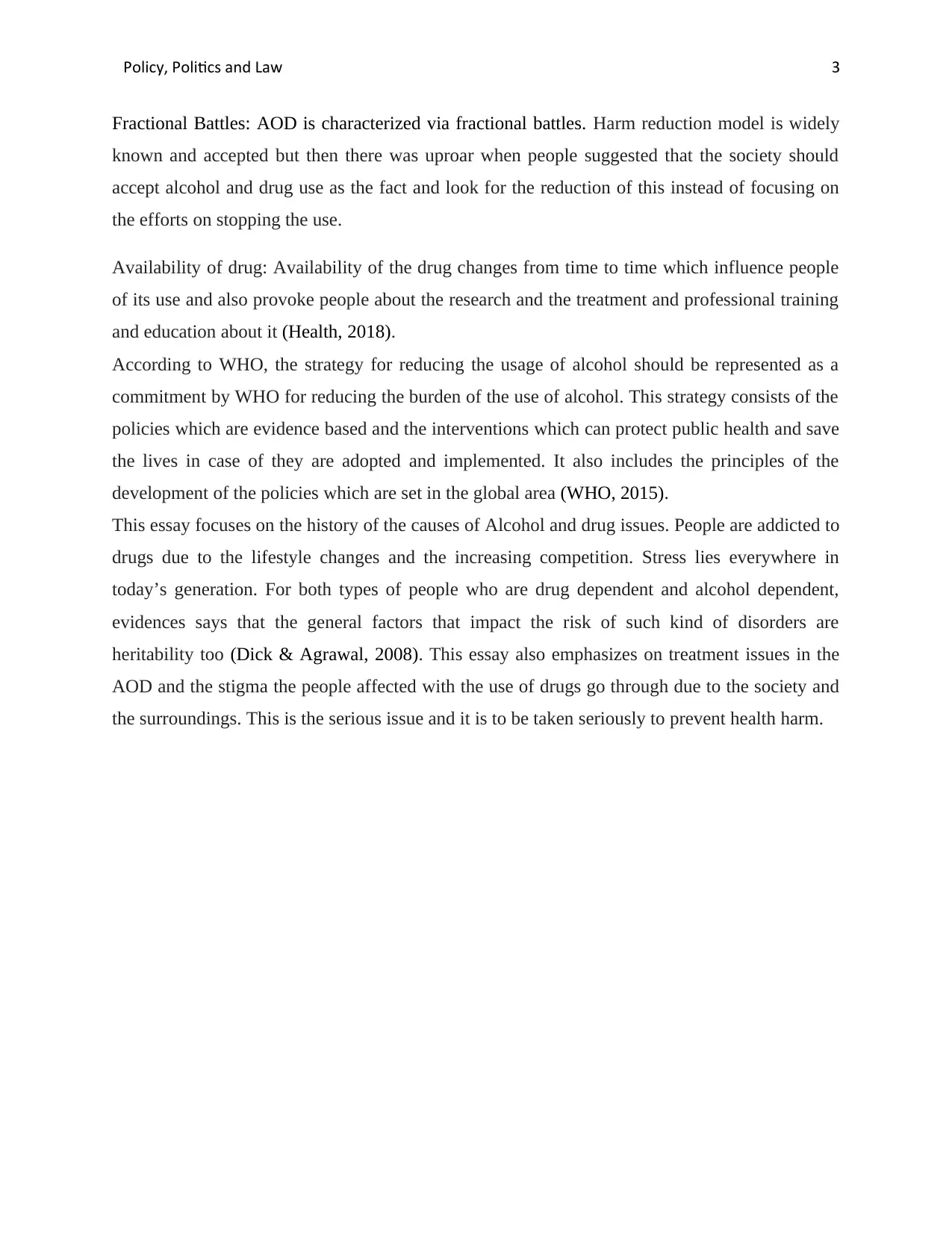
Policy, Politics and Law 3
Fractional Battles: AOD is characterized via fractional battles. Harm reduction model is widely
known and accepted but then there was uproar when people suggested that the society should
accept alcohol and drug use as the fact and look for the reduction of this instead of focusing on
the efforts on stopping the use.
Availability of drug: Availability of the drug changes from time to time which influence people
of its use and also provoke people about the research and the treatment and professional training
and education about it (Health, 2018).
According to WHO, the strategy for reducing the usage of alcohol should be represented as a
commitment by WHO for reducing the burden of the use of alcohol. This strategy consists of the
policies which are evidence based and the interventions which can protect public health and save
the lives in case of they are adopted and implemented. It also includes the principles of the
development of the policies which are set in the global area (WHO, 2015).
This essay focuses on the history of the causes of Alcohol and drug issues. People are addicted to
drugs due to the lifestyle changes and the increasing competition. Stress lies everywhere in
today’s generation. For both types of people who are drug dependent and alcohol dependent,
evidences says that the general factors that impact the risk of such kind of disorders are
heritability too (Dick & Agrawal, 2008). This essay also emphasizes on treatment issues in the
AOD and the stigma the people affected with the use of drugs go through due to the society and
the surroundings. This is the serious issue and it is to be taken seriously to prevent health harm.
Fractional Battles: AOD is characterized via fractional battles. Harm reduction model is widely
known and accepted but then there was uproar when people suggested that the society should
accept alcohol and drug use as the fact and look for the reduction of this instead of focusing on
the efforts on stopping the use.
Availability of drug: Availability of the drug changes from time to time which influence people
of its use and also provoke people about the research and the treatment and professional training
and education about it (Health, 2018).
According to WHO, the strategy for reducing the usage of alcohol should be represented as a
commitment by WHO for reducing the burden of the use of alcohol. This strategy consists of the
policies which are evidence based and the interventions which can protect public health and save
the lives in case of they are adopted and implemented. It also includes the principles of the
development of the policies which are set in the global area (WHO, 2015).
This essay focuses on the history of the causes of Alcohol and drug issues. People are addicted to
drugs due to the lifestyle changes and the increasing competition. Stress lies everywhere in
today’s generation. For both types of people who are drug dependent and alcohol dependent,
evidences says that the general factors that impact the risk of such kind of disorders are
heritability too (Dick & Agrawal, 2008). This essay also emphasizes on treatment issues in the
AOD and the stigma the people affected with the use of drugs go through due to the society and
the surroundings. This is the serious issue and it is to be taken seriously to prevent health harm.
Paraphrase This Document
Need a fresh take? Get an instant paraphrase of this document with our AI Paraphraser
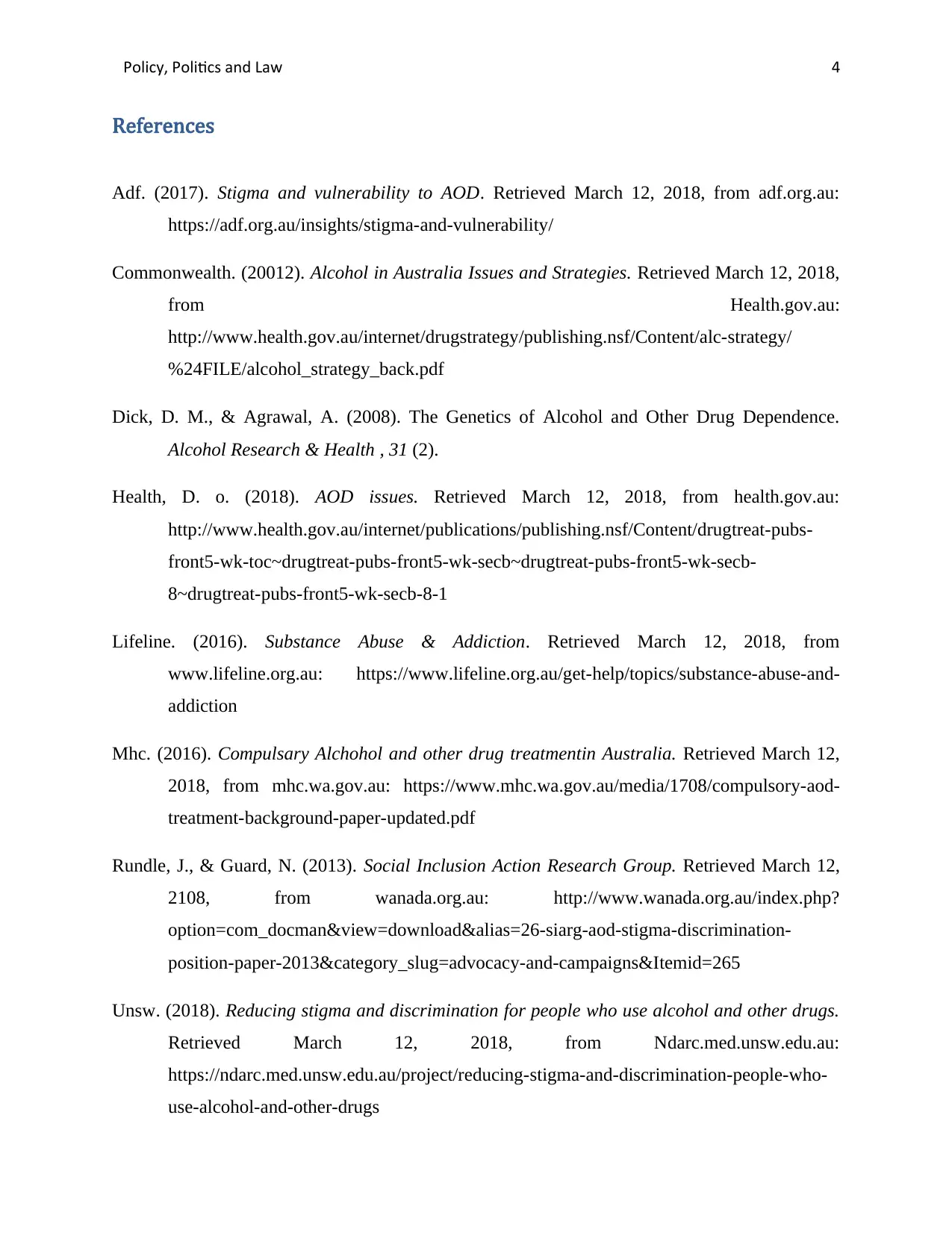
Policy, Politics and Law 4
References
Adf. (2017). Stigma and vulnerability to AOD. Retrieved March 12, 2018, from adf.org.au:
https://adf.org.au/insights/stigma-and-vulnerability/
Commonwealth. (20012). Alcohol in Australia Issues and Strategies. Retrieved March 12, 2018,
from Health.gov.au:
http://www.health.gov.au/internet/drugstrategy/publishing.nsf/Content/alc-strategy/
%24FILE/alcohol_strategy_back.pdf
Dick, D. M., & Agrawal, A. (2008). The Genetics of Alcohol and Other Drug Dependence.
Alcohol Research & Health , 31 (2).
Health, D. o. (2018). AOD issues. Retrieved March 12, 2018, from health.gov.au:
http://www.health.gov.au/internet/publications/publishing.nsf/Content/drugtreat-pubs-
front5-wk-toc~drugtreat-pubs-front5-wk-secb~drugtreat-pubs-front5-wk-secb-
8~drugtreat-pubs-front5-wk-secb-8-1
Lifeline. (2016). Substance Abuse & Addiction. Retrieved March 12, 2018, from
www.lifeline.org.au: https://www.lifeline.org.au/get-help/topics/substance-abuse-and-
addiction
Mhc. (2016). Compulsary Alchohol and other drug treatmentin Australia. Retrieved March 12,
2018, from mhc.wa.gov.au: https://www.mhc.wa.gov.au/media/1708/compulsory-aod-
treatment-background-paper-updated.pdf
Rundle, J., & Guard, N. (2013). Social Inclusion Action Research Group. Retrieved March 12,
2108, from wanada.org.au: http://www.wanada.org.au/index.php?
option=com_docman&view=download&alias=26-siarg-aod-stigma-discrimination-
position-paper-2013&category_slug=advocacy-and-campaigns&Itemid=265
Unsw. (2018). Reducing stigma and discrimination for people who use alcohol and other drugs.
Retrieved March 12, 2018, from Ndarc.med.unsw.edu.au:
https://ndarc.med.unsw.edu.au/project/reducing-stigma-and-discrimination-people-who-
use-alcohol-and-other-drugs
References
Adf. (2017). Stigma and vulnerability to AOD. Retrieved March 12, 2018, from adf.org.au:
https://adf.org.au/insights/stigma-and-vulnerability/
Commonwealth. (20012). Alcohol in Australia Issues and Strategies. Retrieved March 12, 2018,
from Health.gov.au:
http://www.health.gov.au/internet/drugstrategy/publishing.nsf/Content/alc-strategy/
%24FILE/alcohol_strategy_back.pdf
Dick, D. M., & Agrawal, A. (2008). The Genetics of Alcohol and Other Drug Dependence.
Alcohol Research & Health , 31 (2).
Health, D. o. (2018). AOD issues. Retrieved March 12, 2018, from health.gov.au:
http://www.health.gov.au/internet/publications/publishing.nsf/Content/drugtreat-pubs-
front5-wk-toc~drugtreat-pubs-front5-wk-secb~drugtreat-pubs-front5-wk-secb-
8~drugtreat-pubs-front5-wk-secb-8-1
Lifeline. (2016). Substance Abuse & Addiction. Retrieved March 12, 2018, from
www.lifeline.org.au: https://www.lifeline.org.au/get-help/topics/substance-abuse-and-
addiction
Mhc. (2016). Compulsary Alchohol and other drug treatmentin Australia. Retrieved March 12,
2018, from mhc.wa.gov.au: https://www.mhc.wa.gov.au/media/1708/compulsory-aod-
treatment-background-paper-updated.pdf
Rundle, J., & Guard, N. (2013). Social Inclusion Action Research Group. Retrieved March 12,
2108, from wanada.org.au: http://www.wanada.org.au/index.php?
option=com_docman&view=download&alias=26-siarg-aod-stigma-discrimination-
position-paper-2013&category_slug=advocacy-and-campaigns&Itemid=265
Unsw. (2018). Reducing stigma and discrimination for people who use alcohol and other drugs.
Retrieved March 12, 2018, from Ndarc.med.unsw.edu.au:
https://ndarc.med.unsw.edu.au/project/reducing-stigma-and-discrimination-people-who-
use-alcohol-and-other-drugs

Policy, Politics and Law 5
WHO. (2015). Alcohol. Retrieved March 12, 2018, from who.int:
http://www.who.int/mediacentre/factsheets/fs349/en/
WHO. (2015). Alcohol. Retrieved March 12, 2018, from who.int:
http://www.who.int/mediacentre/factsheets/fs349/en/
⊘ This is a preview!⊘
Do you want full access?
Subscribe today to unlock all pages.

Trusted by 1+ million students worldwide
1 out of 6
Related Documents
Your All-in-One AI-Powered Toolkit for Academic Success.
+13062052269
info@desklib.com
Available 24*7 on WhatsApp / Email
![[object Object]](/_next/static/media/star-bottom.7253800d.svg)
Unlock your academic potential
Copyright © 2020–2025 A2Z Services. All Rights Reserved. Developed and managed by ZUCOL.





